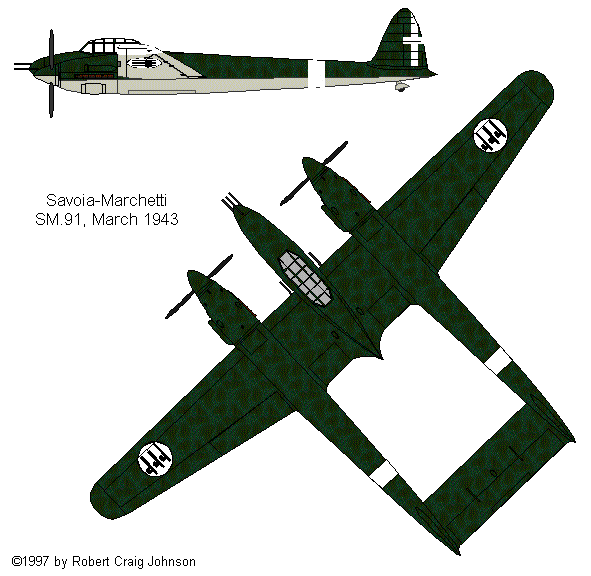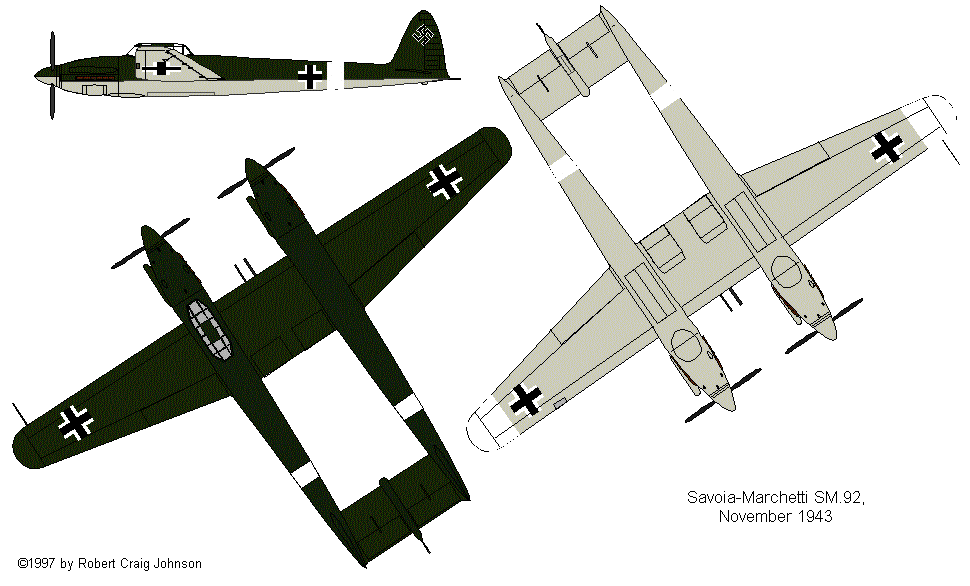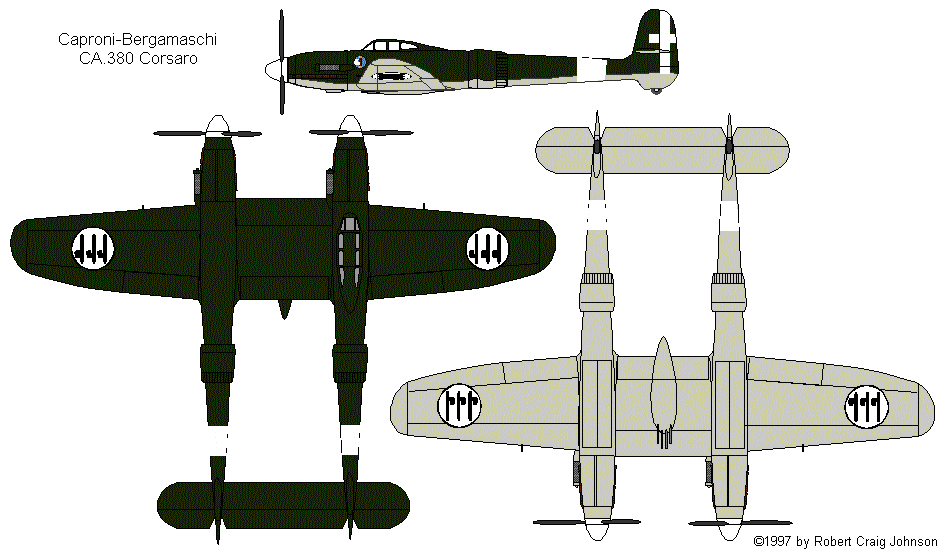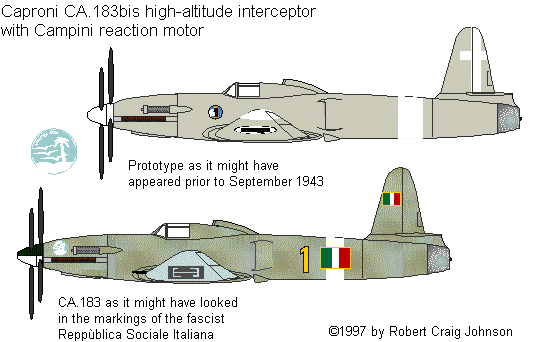
In the years immediately preceding Marshall Badoglio's anti-Fascist coup and the subsequent capitulation to the invading Allies, the Italian aircraft industry was just beginning to emerge from the technical backwater it had occupied since its heyday in the early 1930s. License manufacture of German aeroengines—the Daimler-Benz DB.601 (as the Alfa Romeo R.A.1000 RC44-1a Monsonie) and the DB.605 (as the Alfa Romeo Tifone)—had finally filled the gap left by the failure of Italy's pre-war engine-development programs. In the face of generally disastrous war experience, the Regia Aeronautica had at last abandoned the outmoded, unrealistic tactical doctrines that had hitherto framed the service's requirements. By hastily fitting the German powerplants to existing airframes like the Macchi MC.200, FIAT G.50, and Reggiane RE.2000, the engineers had also met the immediate needs of the Italian pilots at the front. With both time and powerful engines available at last, the Italian aviation industry produced a flood of promising and original, state-of-the-art combat aircraft between 1941 and 1943. Among them were a series of designs for high-performance, high-altitude, twin-engined fighters capable of overtaking and destroying the USAF Lightnings and RAF Mosquitos that were then operating over the Mediterranean countries with relative impunity.
SIAI Savoia-Marchetti designed, built, and tested two twin-engined fighter designs, the SM.91 and a derivative, the SM.92. Both were heavily armed, twin-boom two-seaters powered by pairs of imported, 1475-hp DB.605A-1 engines.
The SM.91 was one of the first all-metal aircraft that Savoia-Marchetti had produced. Its crew of two were housed in a central gondola beneath a large canopy. Three 20-mm Mauser MG.151 cannon were grouped in the nose of the gondola, and a similar gun was fitted in the wing root on either side. The aircraft could carry an 1100-lb bomb or a 218-gal drop tank under the gondola or four 220-lb bombs under the wings. It weighed 14,110 lbs empty and 19,600 lbs loaded.
The SM.91 flew for the first time on 10 March 1943. Performance and handling were good. The airplane could reach a maximum of 363 mph at 22,960 ft and could climb to 19,680 ft in 8 min 30 sec. It had a service ceiling of 36,090 ft and a range of 994 miles at a cruising speed of 320 mph. The SM.91 spanned 64 ft 7.25 in and was 43 ft 5.75 in long. Wing area totaled about 450 sq ft.

While the SM.91 proved thoroughly satisfactory in tests, the Savoia-Marchetti engineers were already looking for ways of boosting performance still further. Since further power would not be immediately forthcoming—the larger displacement DB.603 was not yet available to the Italians—drag reduction seemed the only course open to the designers. Keeping the same engines and the same, basic wing and tail design, the designers abandoned the central gondola and placed the crew in a redesigned port tail boom. They installed two 20-mm MG.151 cannon in the leading edge of a now substantially narrower center section, one MG.151 between the cylinder blocks of the starboard engine, firing through the airscrew hub, and two synchronized, 12.7-mm, Breda-SAFAT machine guns under each engine. The tail wheel now retracted into a pod on the centerline of the horizontal stabilizer. A single, remotely aimed 12.7-mm Breda-SAFAT was mounted at the rear of this pod. The new SM.92 weighed 13,779 lbs empty, 19,290 lbs loaded. It spanned 60 ft 10 in and was 44 ft 11 in long. Wing area totaled about 415 sq ft.

The SM.92 flew November 12, 1943, after Italy's capitulation. All testing was carried out under Luftwaffe control. As the engineers had hoped, performance was significantly better. The SM.92 could reach 382 mph at 29,935 ft, could climb 19,680 ft in 7 min 10 sec, and could reach a service ceiling of 39,370. Range increased to 1242 miles at 335 mph. But it was all for nought. Northern Italy was now to all intents and purposes a province of the German Reich. Her production resources were now German resources. While the Luftwaffe technical evaluation team found the SM.92 interesting, they preferred to devote Italy's resources to the production of existing, German types and types that better fit Luftwaffe requirements and operational doctrine. Work was stopped, and the pilots that remained in the dwindling rump of Fascist Italy retrained on the Bf109G.
The principle competitor to the SM.91/92 remained a paper project only. The Caproni-Bergamaschi CA.380 Corsaro ("Corsair") was an equally radical, twin-boom two-seater. But it could hardly have differed more from its rival. From the first, the Caproni team strove for absolute minimum drag. The two man crew was housed back-to-back in the starboard tailboom behind one of two 1475-hp DB.605 engines. These would be replaced by 1550-hp DB.603s at the earliest opportunity (the DB.605 was a bored-out DB.601 with its displacement limited by the original bore centers, while the DB.603 was a groundup redesign with substantially increased capacity). To reduce the cooling drag of the airframe and radiators, the design team used a refined version of the P-38 radiator layout. Ducted, annular radiators surrounded the tailbooms aft of the wing, where drag-producing interactions between cooling air and airflow over the airframe could be kept to a minimum. Careful design of the ducts and their exit flaps promised to generate enough thrust to offset the remaining cooling drag altogether. The wing had a broad, semielliptical planform. Four 20-mm MG.151 cannon were grouped in a streamlined pod under the center section, and a single, 12.7-mm Breda-SAFAT machine gun was fitted in each outer wing panel, outside the propellor arc. The Corsaro spanned 52 ft 6 in, was 39 ft long, and was to weigh 16,383 lbs (loaded).

The Corsaro never flew. But it ought to have been an excellent airplane. Caproni estimated its maximum speed as 400 mph at 23,525 ft and ceiling as 34,450 ft. It was to climb to 19,680 ft in 7 min 9 sec. Maximum cruising speed was to be 323 mph, and maximum range would lie between 1336-1616 miles.
The last of our Italian might-have-beens typifies the mix of backwardness and visionary originality that permeated Italian aviation during the war early war years. Having rejected the gas-turbine as impractical and futuristic (even as Whittle and Ohain were testing their first engines), the Italians set out to create a complex, afterburning, piston engine-driven, ducted fan. The Caproni-Campini research airplane showed that this system could be made to work (if only just). But the Campini compressor was clearly no competition for a good propellor, all else being equal.

Of course, all things are seldom equal in engineering, and Caproni (Milano) engineers reasoned that a refined Campini system might have advantages in flight regimes where conventional propellors were less efficient. At really high altitudes, the compressor might give an interceptor a very useful amount of extra thrust. Accordingly, a team commenced design work on a specialized high-altitude fighter, the CA.183bis. The CA.183bis had a liquid-cooled, 1250-hp DB.605 in the nose, driving contrarotating 3-bladed propellors. A 700-hp FIAT A.30 air-cooled radial engine drove a Campini compressor in a mid-fuselage duct. Scoops in the fuselage sides provided cooling air for the FIAT engine and air mass for the afterburner. The Campini device was expected to contribute up to 60 mph to the aircraft's 460-mph estimated top speed while endowing the airplane with a maximum range of 1242 miles. The fighter was to carry four 20-mm MG.151 cannon in the wings, outboard of the propellor, and a fifth gun in between the cylinder banks of the DB.605. Design loaded weight was 16,538 lbs.
© 1997 by Robert Craig Johnson.